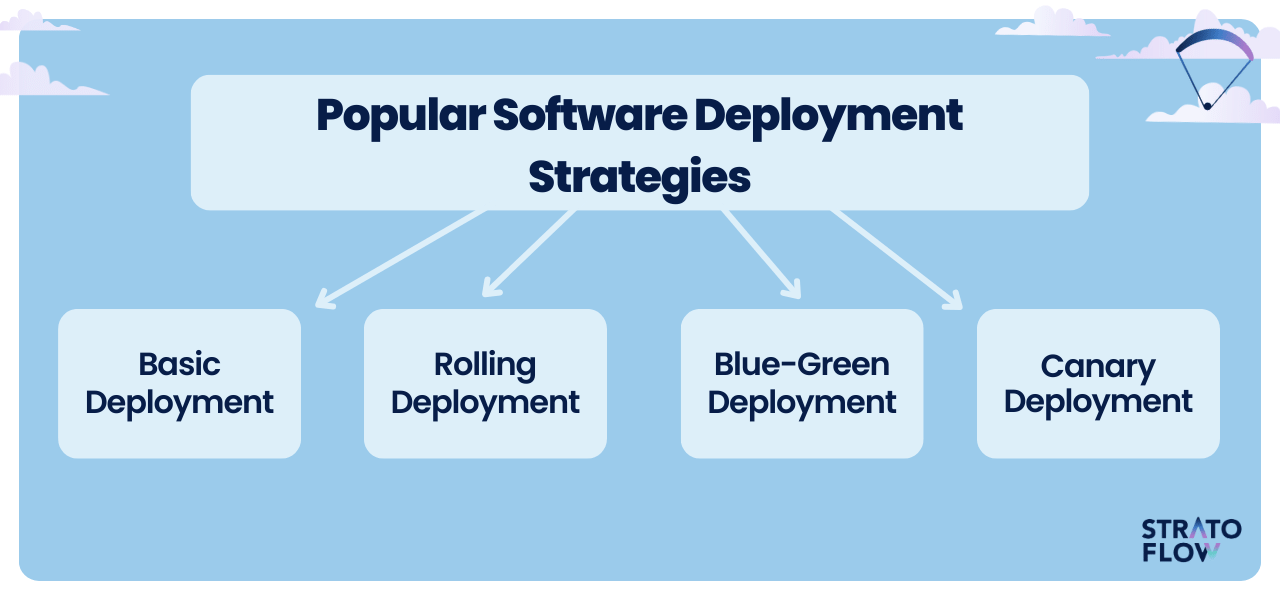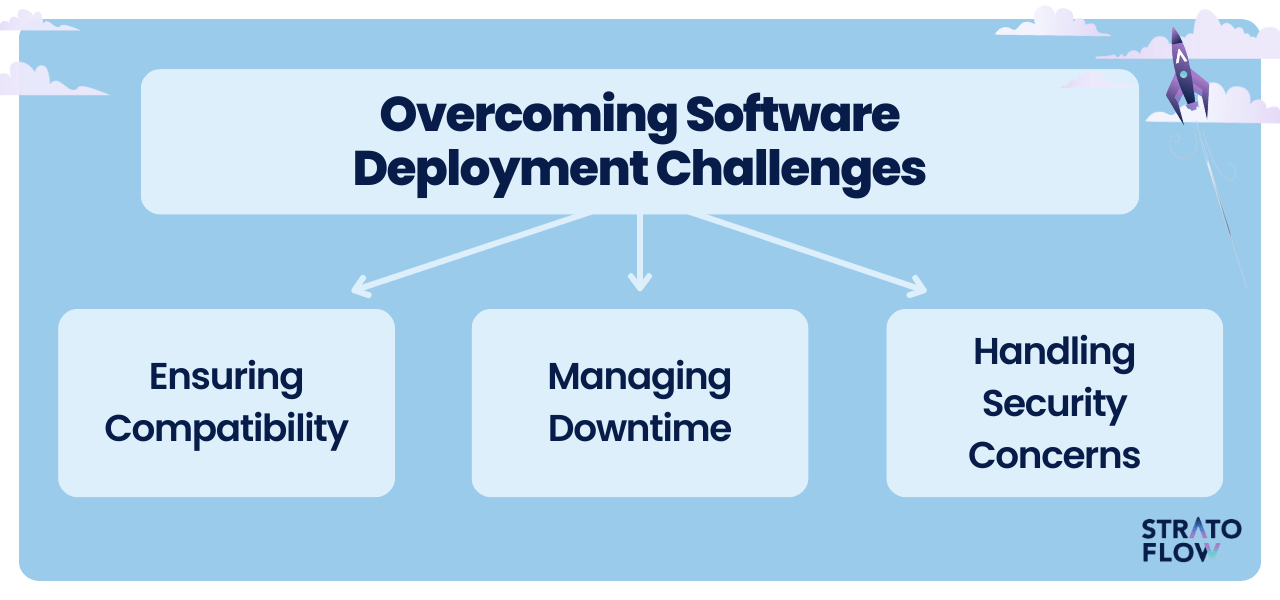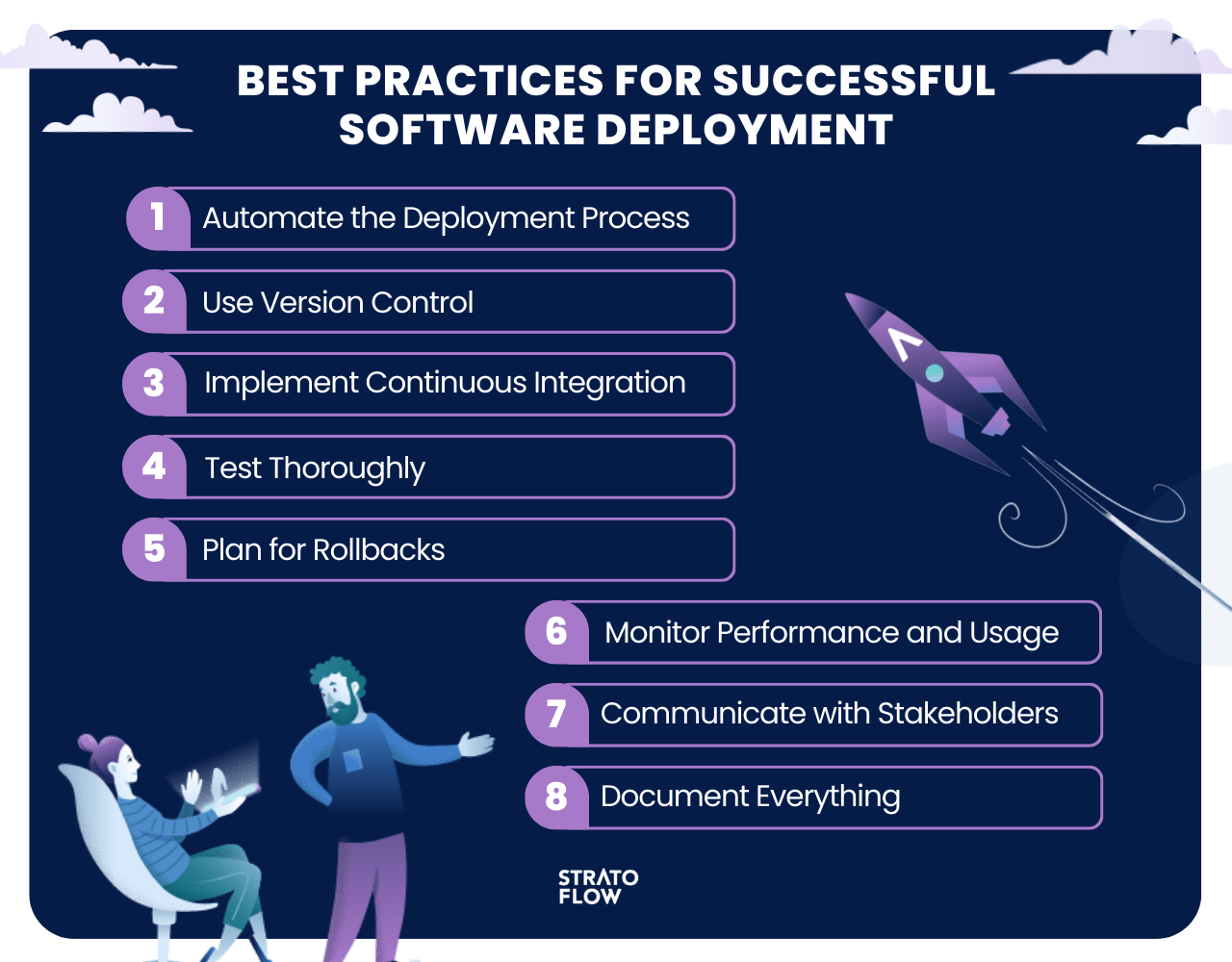
SDLC Guide: Best Practices for Successful Software Deployment Phase
Wondering how to deploy software effectively?
Navigate the complexities of software deployment with this essential guide.
Better understand this vital process, its role in your operations, and the best strategies to adopt for successful deployment. Discover methods to enhance user experience, tighten security, and ensure your software hits the mark every time.
Key Takeaways
- Software deployment is essential for ensuring the smooth integration of new features and updates into business systems, streamlining operations, and delivering a positive end-user experience.
- The software deployment process comprises key components like planning, testing, packaging, and monitoring, with strategies like blue-green and canary deployments being used to minimize risks and downtime.
- Best practices for successful deployment include automation, establishing clear communication channels, and monitoring performance, while leveraging deployment tools like Jenkins and Ansible can enhance efficiency and compliance.
Understanding Software Deployment
Software or application deployment is the last stage in the software development process during which users finally gain access to new or updated versions of software.
It’s a culmination of careful planning, coding, testing, and packaging, where the application is made to work on a target device, be it a test server, production environment, or a user’s computer or mobile device. It’s important to distinguish between software release, the development stage, and software deployment, the delivery stage.
Seamless integration of new features and updates into existing systems is achieved through software deployment and software management, thereby enhancing business processes and catering to evolving needs with timely software releases.
The Role of Software Deployment in Business Operations
Smooth operations, security, and efficiency in business operations are assured by software deployment. It also fosters business continuity, minimizes extensive downtime, and streamlines IT operations.
By streamlining the implementation process, software deployments reduce the time and effort required to deploy new software solutions, enhancing the efficiency of business operations.
The Impact on End-Users
For users, software deployment serves as a direct delivery channel for new features, updates, and bug fixes.
A better user experience is achieved through thorough testing and careful configuration in software deployment, ensuring that the software works seamlessly for the end user. The deployment stage marks the first interaction of end-users with new software solutions, marking its significance in the software development lifecycle.
Key Steps of the Software Deployment Process
Operating like a well-oiled machine, the software deployment process encompasses key components that promise reliable software performance.
From the development process that involves creating a well-structured plan, breaking it into manageable tasks, every step is vital, making software deployment important.
Step 1: Planning and Preparation
This initial step when deploying software involves defining the deployment goals, scope, and schedule.
Teams must identify the resources needed, such as hardware and requirements, and plan for potential risks and mitigation strategies for the new software system. Attention should be paid to understanding the user requirements, the environment where the software will be deployed, and ensuring that all necessary support structures, such as databases and third-party services, are in place and configured properly.
Time and cost
- 20% of the entire process, significant upfront investment in time and resources
Key takeaways
- Define clear deployment objectives and success criteria to ensure all team members understand the goals.
- Assess infrastructure and system dependencies to avoid surprises during deployment.
Step 2: Code Completion and Review
Before moving into testing, it’s essential that the software code is finalized and thoroughly reviewed. This step ensures that the software application meets the project’s quality standards and requirements.
Developers should focus on optimizing the code for performance, security, and maintainability. Peer reviews, static code analysis, and ensuring coding best practices are crucial activities here. This phase is about ensuring that the software is functionally ready and secure before it is handed over for detailed testing.
Time and cost
- 15% of the entire process, moderate cost and time are invested here.
Key takeaways
- Implement code quality standards and conduct peer reviews to catch issues early.
- Use version control best practices to manage changes and facilitate collaboration among developers.
Step 3: Testing and Validation
In this phase, the software undergoes rigorous testing in the test environment to identify and fix bugs, and to verify that it meets all specified requirements.
This includes a variety of tests such as unit testing, integration testing, system testing, and user acceptance testing (UAT). Attention should be focused on automating tests where possible to increase efficiency and coverage, ensuring the software behaves as expected in different environments, and validating the user experience against requirements.
Time and cost
- 30% of the entire process, requiring substantial time and financial investment in testing tools, environments, and personnel to ensure the software meets all requirements and quality standards.
Key takeaways
- Develop a comprehensive test plan that covers all aspects of the application, including functional, security, and performance tests.
- Incorporate feedback from end-users during the UAT phase to ensure the software meets their needs and expectations.
Step 4: Deployment and Rollout
This step involves the actual release of the software to the production environment or end users.
It can be done in stages, such as deploying to a small group of users before a full rollout, to minimize risks. Key considerations include ensuring a rollback strategy is in place, preparing deployment scripts or automation tools to ensure a smooth and repeatable process, and communicating with stakeholders about the deployment schedule and any required actions on their part.
Time and cost
- 20% of the entire process, this step involves potential downtime, and the labor involved in executing the deployment plan, with scalability depending on the complexity of the deployment strategy.
Key takeaways
- Use automated deployment tools to streamline the deployment process and reduce human error.
- Prepare a detailed rollback plan in case the deployment encounters critical issues that cannot be resolved in the production environment.
Step 5: Monitoring and Maintenance
After deployment, continuous monitoring is necessary to ensure the software operates as intended and to quickly address any issues that arise. This includes performance monitoring, bug fixing, and applying updates or patches as needed. Attention should be paid to collecting user feedback, monitoring system health indicators, and planning for future updates or improvements based on real-world use.
Time and cost
- 15% of the entire process, Ongoing costs are incurred for monitoring tools and staff to maintain the software, address issues, and implement updates.
Key takeaways
- Set up monitoring tools to track performance, usage patterns, and error logs for proactive issue resolution.
- Establish a process for regular updates and patches to address security vulnerabilities and enhance functionality based on user feedback.
Popular Software Deployment Strategies
Several popular strategies have emerged in the industry for software deployment, including:
- Basic deployment
- Rolling deployment
- Blue-green deployment
- Canary deployment
Each software deployment process is distinct and customized to cater to specific business and deployment requirements.
Basic Deployment
Basic deployment is a straightforward process that is fast and cost-effective.
It’s often used when advanced strategies are not necessary, making it suitable for non-critical applications or lower environments. However, it’s also the riskiest strategy and may lead to significant challenges in maintaining uptime and executing rollbacks.
Rolling Deployment
Rolling deployment is a strategy where old application software is replaced with the new one progressively, rather than doing it all at once.
This gradual process can lead to minimized downtime and reduces the risk involved in the deployment process. However, during rolling deployment, the existence of multiple versions of the software running at the same time can create security vulnerabilities.
Blue-Green Deployment
Blue-green deployment involves maintaining two versions of an application, the current (blue) and the new (green), with only one live at a time. By setting up two identical production environments and directing traffic between them, blue-green deployment achieves nearly zero downtime during software updates.
This strategy enables instant rollbacks to the previous stable version in case of any issues with the new version, reducing the risk during deployment.
Canary Deployment
Canary deployment is a strategy where a new version, including new features or changes, is incrementally released to a limited number of users in the production environment. This method enables rapid updates, fostering a high development velocity and shortening the release cycle. However, this strategy carries the potential risk of exposing vulnerabilities to a part of the user base.
[Read also: Off the Shelf vs Custom Software: Pros & Cons + Examples]
Overcoming Software Deployment Challenges
While software deployment offers numerous advantages, it may also present certain challenges. These challenges can range from resistance from end-users and issues in managing software on customer devices to problems such as project abandonment after development.
Ensuring Compatibility
Differences in operating system versions or hardware specifications can give rise to compatibility issues in software deployment. To resolve compatibility challenges, it’s important to adopt technologies such as virtualization or containerization, for example Docker, to ensure consistent software running across different environments.
Cross-platform development frameworks can help in creating software that works on various operating systems and devices right from the start.
Managing Downtime
Significant challenges can occur due to downtime during software deployment. A well-planned software deployment can reduce the risk of issues or downtime during implementation. High availability strategies, such as load balancers for web servers and replication for databases, decrease the risk of a single point of failure in deployments.
To manage downtime effectively, implementing proper monitoring and alerting systems can help detect and address issues proactively.
Handling Security Concerns
The paramount concern in software deployment is security. Implementing access controls and using version control systems are key methods to mitigate the risk of code tampering during software deployment. Code reviews, automated security scans, and environment hardening are essential secure software deployment practices to identify vulnerabilities and minimize exploits.
Maintaining and regularly auditing a standard secure configuration is crucial to ensure security throughout the deployment lifecycle.
[Read also: Strangler Pattern for Application Modernization]
Best Practices for Successful Software Deployment
The success of software deployment isn’t solely dependent on the right strategies or overcoming challenges. It’s also about following best practices that streamline the process and ensure the software is deployed efficiently and effectively.
Implementing Automation
Deploying automation in software deployment delivers critical benefits like:
- Enhanced efficiency
- Reduced human error
- Consistency
- Scalability
- Cost-effectiveness
Configuration management automates infrastructure management and deployment, bringing system administration under the umbrella of software engineering, which aids agile teams in prioritizing and triaging configuration work efficiently.
Establishing Clear Communication Channels
Effective communication forms the backbone of successful software deployment. A communication plan should include:
- Channels of communication
- Frequency of communication
- Stakeholders involved
- Regular status meetings
- Progress reports
- Updates
This plan ensures that all parties are informed and involved throughout the software deployment process.
Informing all stakeholders about upcoming deployments, using simple and consistent language, and maintaining transparency about progress, potential delays and the reasons behind them is essential to maintain trust and manage client relationships during deployment.
Monitoring and Measuring Performance
A key aspect of successful software deployment is the monitoring and measurement of performance. Application performance metrics are essential for measuring the success of software deployment, including:
- Availability
- End-user experience
- Resource utilization
- Reliability
- Responsiveness
Monitoring error rates is vital to quickly identifying and addressing issues within a deployed application, requiring attention to various error indicators.
[Read also: What You Need to Know About Custom Software Development in 2024]
Leveraging Software Deployment Tools
Leveraging Software Deployment Tools during the deployment stage is crucial for streamlining and automating the process of getting software from development to production environments.
These tools help in managing the complexities of deploying applications across various platforms and environments, ensuring consistency, reducing manual errors, and speeding up the deployment cycles. They support continuous integration and continuous deployment (CI/CD) practices, enabling teams to release updates more frequently and with higher confidence.
By automating tasks such as code compilation, testing, and release management, deployment tools significantly enhance operational efficiency and allow developers to focus on building features rather than worrying about deployment logistics.
Some key deployment tools include:
- Jenkins: An open-source automation server that facilitates continuous integration and continuous deployment.
- GitLab CI/CD: Provides a single application for the entire software development and deployment lifecycle.
- Ansible: An open-source tool for software provisioning, configuration management, and application deployment.
- Docker: A platform for developing, shipping, and running applications inside containers, making deployments consistent across environments.
- Kubernetes: An open-source system for automating deployment, scaling, and management of containerized applications.
- Terraform: An infrastructure as code (IaC) tool used to provision and manage any cloud, infrastructure, or service.
- Chef: A powerful automation platform that transforms infrastructure into code for server deployment and management.
- Puppet: An open-source software configuration management and deployment tool.
These tools play a pivotal role in modern software development and deployment strategies, offering scalability, reliability, and automation to the deployment process.
Other Phases of The Software Development Process
Software development process is a structured process that involves several critical phases before reaching the deployment stage. The journey begins with Requirement Analysis phase, where the team gathers and analyzes the needs of the end-users or stakeholders to understand what the software should achieve. This phase is crucial for defining clear and precise specifications that guide the entire development process.
Following requirement analysis, the Planning phase sets the project’s roadmap, outlining timelines, resources, and budgets needed to meet the project goals. It involves selecting the right technology stack, defining milestones, and allocating tasks among the development team.
Next comes the Design phase, where architects and designers create the software’s architecture and user interface. This step transforms requirements into a blueprint for building the software, focusing on usability, performance, and flexibility.
The Development phase is where the actual coding happens. Developers write code to implement the functionalities outlined in the design documents, using programming languages and tools suited to the project. This phase is iterative, often involving multiple cycles of development and revision to refine the software.
Testing is conducted parallel to and after the development phase to ensure the software works as intended. This includes identifying and fixing bugs, verifying that the software meets all requirements, and ensuring it is ready for real-world use. Testing and maintenance can involve a mix of automated and manual tests, including unit testing, integration testing, system testing, and user acceptance testing (UAT).
Each of these phases plays a vital role in the software development process, contributing to the creation of high-quality, efficient, and user-friendly software products that meet or exceed stakeholder expectations.
Summary
In conclusion, software deployment is a crucial aspect of the software development process that ensures the seamless integration of new features and updates, enhances business processes, and meets evolving needs.
With various deployment strategies and tools available, it’s vital to choose the ones that best meet your specific business and deployment needs.
Always remember, a successful software deployment is not just about the right strategy or overcoming challenges, but also about following best practices and leveraging the right tools.
Frequently Asked Questions
What do you mean by software deployment?
Software deployment refers to the process of making an application accessible and operational on a target device. It could be a test server, production environment, or a user’s computer or mobile device. The process involves making the software available to be used by users and other programs, and it encompasses activities such as installation, configuration, and testing, ensuring the software runs effectively in the target environment.
What are the steps for software deployment?
The main steps for software deployment include planning and assessment, development or configuration, testing and quality assurance, deployment, and monitoring and maintenance. These steps are crucial to ensure a successful deployment process.
What is the meaning of system deployment?
System deployment refers to the critical activity of delivering a new or updated software or hardware solution to end users or customers, ensuring operational acceptability and effective transfer of responsibility to the owner. It involves planning, testing, installation, configuration, training, and support activities to meet stakeholder requirements and expectations.
What is the difference between software release and software deployment?
The main difference between software release and deployment is that release involves developing the application, whereas deployment involves delivering it to users.
What are some popular software deployment strategies?
Popular software deployment strategies include basic deployment, rolling deployment, blue-green deployment, and canary deployment. Each strategy has its own benefits and best use cases.
Related Posts
- How to Build an Inventory Management System: Key Steps and Tips
- How to Build a Document Management System: Alternative Approach
- Online Shopping Recommendations – Introducing Them to Your Business
- Amazon Product Recommendation System: How Does Amazon Algorithm Work?
- Movie Recommendation Systems: A Business Guide
Thank you for taking the time to read our blog post!









